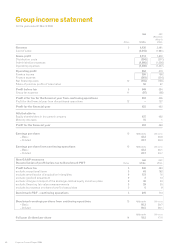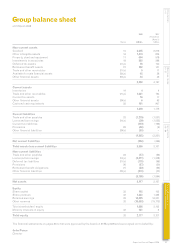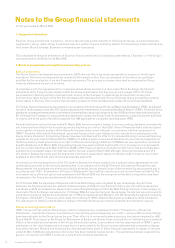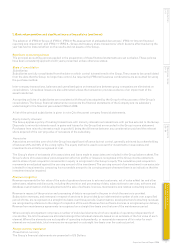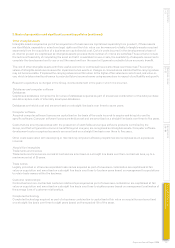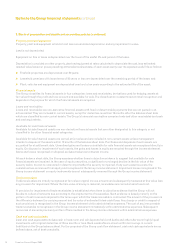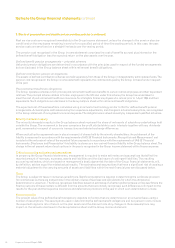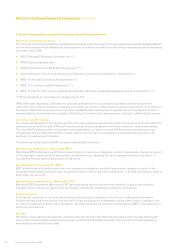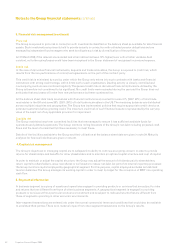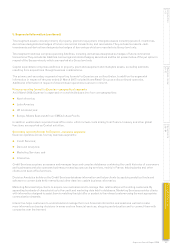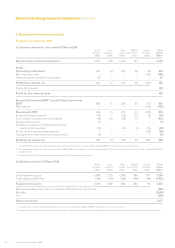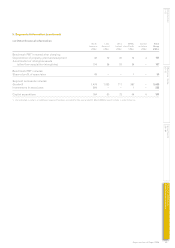Experian 2008 Annual Report Download - page 77
Download and view the complete annual report
Please find page 77 of the 2008 Experian annual report below. You can navigate through the pages in the report by either clicking on the pages listed below, or by using the keyword search tool below to find specific information within the annual report.
75Experian Annual Report 2008
Introduction
2 – 5
Business review
6 – 37
Governance
38 – 64
Financial statements
Group financial statements
Financial statements
Group financial statements
2. Basis of preparation and significant accounting policies (continued)
Borrowings and borrowing costs
Borrowings are measured at amortised cost except where they are hedged by an effective fair value hedge, in which case the
carrying value is adjusted to reflect the fair value movements associated with the hedged risk.
Borrowings are classified as non-current to the extent that the Group has an unconditional right to defer settlement of the
liability for at least 12 months after the balance sheet date.
Incremental borrowing costs which are directly attributable to the issue of debt are capitalised and amortised over the expected
life of the borrowing using the effective interest rate method. All other borrowing costs are expensed in the year in which they
are incurred.
Accounting for derivative financial instruments and hedging activities
The Group uses derivative financial instruments to manage its exposures to fluctuations in foreign exchange rates,
interest rates and certain obligations, including social security obligations, in respect of share-based payments. Derivative
instruments utilised by the Group include interest rate swaps, cross currency swaps, foreign exchange contracts and equity
swaps. These are recognised as assets or liabilities as appropriate.
Derivative financial instruments are recognised at cost, being the fair value at the date a contract is entered into, and are
subsequently remeasured at their fair value. Depending on the type of derivative financial instrument, fair value calculation
techniques include, but are not limited to, quoted market value, present value of estimated future cash flows (of which
the valuation of interest rate swaps is an example) and exchange rates at the balance sheet date (of which the valuation
of foreign exchange contracts is an example). The method of recognising the resulting gain or loss depends on whether the
derivative is designated as a hedging instrument and, if so, the nature of the hedge relationship. The Group designates certain
derivatives as:
Fair value hedges – hedges of the fair value of recognised assets or liabilities or a firm commitment; or
l
Cash flow hedges – hedges of a particular risk associated with a recognised asset or liability or a highly l
probable forecast transaction; or
Net investment hedges – hedges of net investments in operations whose functional currency is not the US Dollar.
l
The Group documents the relationship between hedging instruments and hedged items at the hedge inception, as well
as its risk management objective and strategy for undertaking various hedge transactions. The Group also documents
its assessment, both at hedge inception and on an ongoing basis, of whether the derivatives that are used in hedging
transactions are highly effective in offsetting changes in fair values of hedged items. This effectiveness testing is
performed at every reporting date throughout the life of the hedge to confirm that the hedge has remained and will
continue to remain highly effective. Movements on the hedging reserve in equity are shown in the Group statement of
recognised income and expense.
Hedge accounting is discontinued when the hedging instrument expires or is sold, terminated or exercised or no longer
qualifies for hedge accounting.
Derivative assets and liabilities are classified as non-current unless they mature within 12 months after the balance sheet date.
Amounts payable or receivable in respect of interest rate swaps are taken to net financing costs over the period of the contract
together with the interest differential reflected in foreign exchange contracts.
Fair value hedges
Changes in the fair value of derivatives that are designated and qualify as fair value hedging instruments are recorded
in the Group income statement, together with any changes in the fair value of the hedged asset or liability that are
attributable to the hedged risk. The ineffective portion of a fair value hedge is recognised in net financing costs in the
Group income statement.



